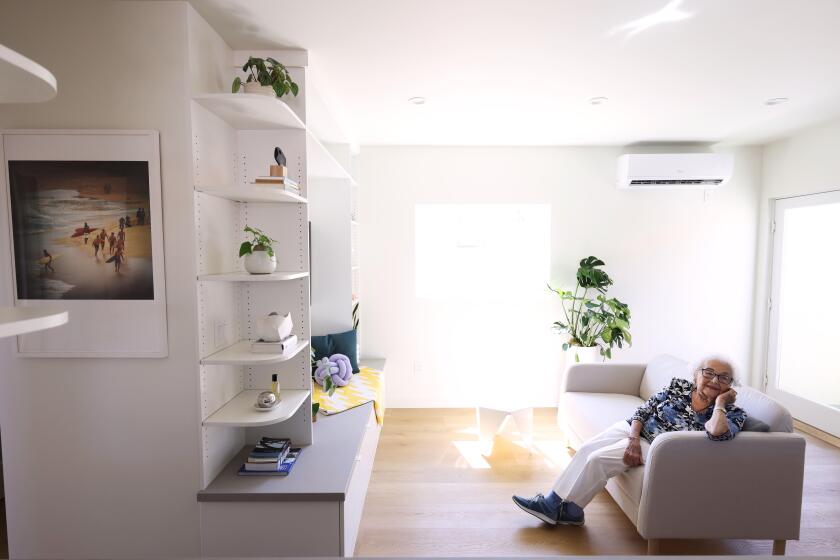West’s Old Buildings Falling Prey to Progress
KETCHUM, Idaho — Bob Rosso has had to make many accommodations to the past during the last three decades as he expanded his backcountry equipment retailing and rental business from its beginnings in the 1882 home of one of central Idaho’s pioneers.
“There aren’t many of these old buildings left,” the owner of the Elephant Perch in Ketchum said. “It would have been easier to knock it down. But we wanted to retain the history. It’s an inconvenience to maintain all these little spaces, but it has something special about it.”
Rosso’s view, however, is being increasingly challenged with the disappearance of other buildings marking the town’s beginnings as a mining center and its transition into an early 20th Century livestock hub -- victims of Ketchum’s evolution into a playground for the wealthy where property values are rising 10% a year.
“In the past three years we were amazed at how many buildings that were on our historic inventory were gone,” said architect James Ruscitto, chairman of the newly reconstituted Historic Preservation Commission.
“It’s a reawakening for the city,” Ruscitto said. “Property values have gotten to the point where they’re knocking down almost new buildings for development.”
The problem isn’t peculiar to Ketchum and the world-renowned Sun Valley resort a mile down the road. Critics say it haunts the entire West, where rapid population growth has fueled skyrocketing property values that jeopardize historic properties and the region’s way of life.
“We have a responsibility to future generations to save buildings so they can have that physical connection with their history,” said Mike Buhler of the National Trust for Historic Preservation. “Without that, you can look there and not know what came before.”
The trust’s list of historic sites in jeopardy is long and varied. It includes the Willits, Calif., ranch where the horse Seabiscuit was rehabilitated in 1939. It covers historic neighborhood schools victimized by deferred maintenance. It has inner-city churches, highlighted by the fight in downtown Seattle to put a high-rise office tower on the site of the century-old First United Methodist Church.
“When it comes to dollars and cents, it’s difficult to convince individuals and corporations that there is a value to the historical significance of buildings or sites that outweighs the financial value,” Idaho State Historical Society Director Steve Gerber said. “Where property values are really skyrocketing, that’s putting pressure on historical buildings.”
The reality of value versus history is no more evident than in Ketchum, where land in the city core goes for around $125 a square foot.
The Bald Mountain Hot Springs Hotel, which features a pool filled with hot water moved through wooden pipes from a natural hot springs two miles away, was a central attraction after it was built in 1929.
“It was the focus of Ketchum,” said Mary Jane Conger, a native whose family helped settle the area. “It was a real era.”
But the lodge was sold off and moved to a ranch 100 miles south and the cabins were being removed to make room for an 80-room hotel when the project’s financing fell through. Now the lot is back on the market for a reported $6 million.
“An interesting historic building is gone,” Ruscitto said, “and now we have a half-vacant lot.”
Local history enthusiasts, led by Conger and real estate agent Anne Zauner, are trying to come up with a plan to at least save the cabins that are left, possibly converting them to office space.
“We’re starting to realize that we do have a history here, a rich history and if we don’t save it, we’re going to lose our character,” Zauner said.
While there may be the odd wealthy patron who steps in to save a building because he has no need for more cash, real estate agent Dick Fenton says those cases are few.
His office sits next to a 5,000-square-foot lot worth about $600,000. On it is a 750-square-foot log cabin built in 1938 that is now a restaurant paying relatively limited rent.
“It’s a 4% return so you’re not going to hold it,” Fenton said. “If you’re looking at it from an investment point, you’d build an office building with condos on top.”
“The difficulty is you’re a landowner sitting on land that’s worth so much,” he said. “You need incentives. It has to be in the interest of the landowner. He says, ‘All my money’s tied up in this funky little house that you call historic and I call barely habitable.’ ”
There are limited incentives -- a federal tax credit and some grants. But Ruscitto and others agree there isn’t enough money to offset the cash that development typically generates. Preservation has to be done for its own value, they said, fostered by community support for history.
Some communities have used zoning ordinances to prohibit demolition, though Fenton believes that in the case of many old buildings that kind of restriction on private property rights would not hold up in court. One viable option, he says, is letting landowners sell their development rights to others, who could then increase the density of their developments beyond what would otherwise be allowed. But that market has yet to take hold, he said.
Ruscitto believes there are other ways to accommodate development plans for the sites of old buildings without completely destroying the buildings. They could be converted to contemporary uses like stores or offices or zoning laws could be used to require at least some investigation into an old structure’s history before demolition is considered. Owners could be advised on any incentives to help offset gains from demolition.
His firm’s office incorporates much of a home built in 1946 with boards taken from timber logged in nearby Trail Creek for a prominent business family. The preservation commission is also putting up plaques on preserved buildings, identifying the original use and construction date.
“Just having people see these buildings turned into shops and restaurants is important,” Ruscitto said. “You can’t stop progress, but there are many ways to pay respect to these buildings.”
More to Read
Sign up for The Wild
We’ll help you find the best places to hike, bike and run, as well as the perfect silent spots for meditation and yoga.
You may occasionally receive promotional content from the Los Angeles Times.






